Creationism
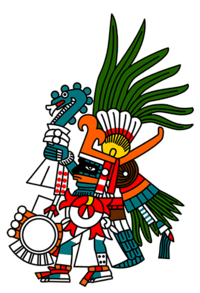
Creationism appears to be a system of interpreting scientific evidence which uses the Bible as a basis for interpretation. This can be contrasted with evolution which apparently uses methodological naturalism as its basis for interpretation.
"Huitzilopochtli [on the right] was the patron god of the Mexica tribe. Originally he was of little importance to the Nahuas, but after the rise of the Aztecs, Tlacaelel reformed their religion and put Huitzilopochtli at the same level as Quetzalcoatl, Tlaloc, and Tezcatlipoca, making him a solar god."[1]
Religions
"The religions of all ancient nations ... associate the abode of the supreme God with the North Pole, the centre of heaven; or with the celestial space immediately surrounding it."[2]
Radiation
In 1960, with respect to the theory of evolutionary progressivism, Huxley wrote "Improved organization gives biological advantage. Accordingly, the new type becomes a successful or dominant group. It spreads and multiplies and differentiates into a multiplicity of branches. This new biological success is usually achieved at the biological expense of the older dominant group from which it sprang or whose place it had usurped."[3]
Astronomy
"In astronomy, cosmogony refers to the study of the origin of particular astrophysical objects or systems, and is most commonly used in reference to the origin of the solar system.[4][5]"[6]
Cosmogony “is any scientific theory concerning the coming into existence, or origin, of the cosmos or universe, or about how what sentient beings perceive as "reality" came to be.”[6]
The hominins of Earth may have observed and recorded a genealogy, or a begetting, of astronomical objects. Such a begetting may be called an astrogony.
Their astronomical observations may have suggested a genealogy, a progression from one astronomical object to another from the point of view of Earth. These objects may have been recorded and perhaps regarded based on what was observed.
Planetary sciences
At least in the northern hemisphere of Earth, the local hominins may have observed, recorded, and regarded a progression of astronomical objects in the sky.
These objects have been remarkable enough that they have made their presence known to the locals of Earth. The time frame could be as short as 10,000 years or as long as a million.
From the current state of knowledge about astronomical objects around other stars, especially nearby, it may be possible to imagine similar objects in the solar system to account for these observations.
Since hominins are recording these phenomena, it is reasonable that these phenomena occurred during an oral history into a written history in some form.
Minerals
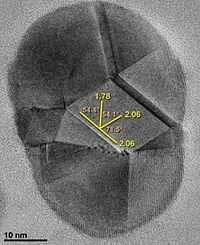
"At the end of the Pleistocene era around 13,000 years ago, North America lost most of its megafauna—including mastodons, giant ground sloths, saber-toothed cats, and short-faced bears. Some researchers think the mass extinction was caused by climatic changes or maybe even humans; others think it was the abrupt environmental changes resulting from a comet collision with Earth that led to the Younger Dryas period of global cooling just a couple centuries later."[7]
The "same cosmic impact that took out the Pleistocene megafauna may have also created tiny diamonds across at least three continents around 12,800 years ago."[7]
"Cosmic collisions such as these produce a type of material called nanodiamonds. To date, the only other layer where more than one nanodiamond has been found is the Cretaceous-Tertiary boundary (now known as the Cretaceous-Paleogene boundary) from 65 million years ago, famous for the extinction of dinosaurs."[7]
At "32 sites in 11 countries [...] an abundance of nanodiamonds distributed over 50 million square kilometers across the Northern Hemisphere at the Younger Dryas boundary (YBD)—a carbon-rich layer that appears as a thin black line just a few meters below the surface [has been found]."[7]
“We conclusively have identified a thin layer over three continents, particularly in North America and Western Europe, that contain a rich assemblage of nanodiamonds, the production of which can be explained only by cosmic impact."[8]
“These are exotic conditions that came together to produce the diamonds from terrestrial carbon. [...] The diamonds did not arrive with the incoming meteorite or comet. [...] The diamonds did not arrive with the incoming meteorite or comet.”[8]
Theoretical creationism
Def.
- the "doctrine that each individual human soul is created by God (in Christianity, Judaism, Islam and the Baha'i Faith), as opposed to traducianism",[9]
- "a belief that the origin of things is due to an event or process of creation brought about by the deliberate act of any divine agency, such as a Creator God (creator god)",[9]
- the "belief that a deity created the world, especially as described in a particular religious text, such as the Quran or the Book of Genesis",[9] or
- any belief of "or relating to"[10] all "which exists",[11] the "act of"[11] something "put into existence",[12] designed, invested "with a new form, shape, etc.",[12] "imaginative",[12] or caused, brought "a (non-object) about by action",[12] "such as an invention or artwork",[11]
is called creationism.
Entities
Def. a "conjecture claiming that biological life on Earth, or more broadly, the universe as a whole, was created by a (specified or unspecified) intelligent agent rather than being the result of undirected natural processes"[13] is called intelligent design.
"Anaxagoras (500–428 B.C.) was the first of the Greeks "to attribute the adaptations of Nature to Intelligent Design, and was thus the founder of Teleology,"[14] an idea that has played a retarding function in the history of evolution."[13]
"Intelligent design means that the various forms of life began abruptly through the agency of an intelligent creator with their distinctive features already intact—fish with fins and scales, birds with feathers, beaks, and wings, etc."[15]
Def. the "doctrine that the soul or spirit is inherited from one or both parents"[16] is called traducianism.
Def. the "spirit or essence of a person usually thought to consist of one's thoughts and personality"[17] or the "spirit or essence of anything"[17] is called a soul.
Def.
- the "main religious text in Christianity",[18]
- the "Jewish holy book that was largely incorporated into the Christian Bible",[18]
- the "analogous holy book of another religion",[18] or
- a "specific version, edition, translation, or copy of one of the [below]-mentioned texts"[18]
is called a Bible.
Coordinate terms
- "scripture, religious text; Adi Granth, Aqdas, Avesta, Bible, Book of Shadows, Dianetics, Geniocracy, Liber AL vel Legis, Ofudesaki, Qur'an, Satanic Bible, Tao Te Ching, Torah, Tripitaka, Veda"[18]
Sources
"There is one God, greatest among gods and men, neither in shape nor in thought like unto mortals ... He abides ever in the same place motionless, and it befits him not to wander hither and thither."[19]
"Saturn, the old man who lives at the north pole, and brings with him to the children of men a sprig of evergreen (the Christmas tree), is familiar to the little folks under the name Santa Claus, for he brings each winter the gift of a new year."[20]
"Lenormant, speaking of Rome and Olympia, remarks, "It is impossible not to note that the Capitoline was first of all the Mount of Saturn, and that the Roman archaeologists established a complete affinity between the Capitoline and Mount Cronios in Olympia, from the standpoint of their traditions and religious origin (Dionysius Halicarn., i., 34). This Mount Cronios is, as it were, the Omphalos of the sacred city of Elis, the primitive centre of its worship. It sometimes receives the name Olympos."1 Here is not only symbolism in general, but also a symbolism pointing to the Arctic Eden, already shown to be the primeval mount of Kronos, the Omphalos of the whole earth.2"[2]
Objects

.jpg)
It is possible that at some point in hominin existence, the Sun with the Earth in orbit around it was in a binary system with a second star. With the orbit of the Earth around the Sun being similar to what it is now, the axial tilt of the Earth being similar to what it is now, the Earth-Sun system may in turn have been in such an orbit around the second, probably smaller star, that this star was a northern hemisphere pole star for the Earth.
Def. "God, in Islamic or Arabic contexts"[21] is called Allah.
"We are too much men and women; we are yet formed in the image of the Creator, and what can we say of Him with any certainty except that He, whoever He may be—Christ, Yahweh, Allah—He made us, did He not, because even He in His Infinite Perfection could not bear to be alone."[22]
Usage notes
"While the Arabic الله is used generically to refer to God in Jewish, Christian, and Islamic contexts, current English usage almost always restricts the corresponding term Allah to Islamic contexts only. Various newspaper style manuals recommend translating the Arabic word in English as God, as this better reflects Arabic usage, but the term is often left untranslated in Islamic contexts. Thus either “Allah is great” or “God is great” may be seen."[21]
Def.
- the "single deity of various monotheistic religions",[23]
- the "single male deity of various bitheistic or duotheistic religions",[23]
- an "impersonal and universal spiritual presence or force",[23]
- "creator of the universe (as in deism)",[23] or
- the "(personification of the) laws of nature"[23]
is called God.
Usage notes
"God is often referred to by masculine pronouns, not necessarily implying that the speaker believes God to be male. God is also referred to by pronouns that begin with a capital letter, as a sign of respect, in many languages written in Latin script. In English, these include He, Him, His and Himself. Many Jews follow a prohibition in their tradition against using this term and other equivalents in writing (see G-d)."[23]
Synonyms
- "Allah, Almighty, cosmocrat, Divine Father, G-d, god, Jah, Jehovah, Lord, LORD, Most High, Yahweh, Brahman, Ahura Mazda, Ra, Waheguru, Sage, Odin, Zeus"[23]
"Saturday is the day of Saturn, and the color of Saturn, according to astronomers, is said to be black"[24].
There is some resemblance between the color of God in Michelangelo's "The Creation" and that of Saturn.
Strong forces
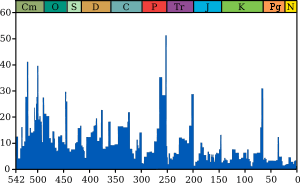
Def. "[t]he action of making or becoming"[25] "[n]o longer in existence; having died out"[26] is called extinction.
Def. the apparent percentage (not the absolute number) of marine animal genera represented by those that are readily fossilized becoming extinct during any given time interval is called the genus extinction intensity.
Evolution

Def.
is called a volution.
Def. "gradual directional change especially one leading to a more advanced or complex form"[28] is called evolution.
Def. "[t]he change in the genetic composition of a population over successive generations"[28] is called evolution.
Def. "any change across successive generations in the heritable characteristics of biological populations"[29] is called evolution.
Modern evolutionary synthesis: "Other previously dominant groups of organisms that also became extinct at the end of the Cretaceous are many marine taxa, such as most nautiloids and the ammonities, both of whom had been previously highly successful organisms."[30] Page 320 of the 2001 book: "Ernst Mayr is the biologist largely responsible for shaping the modern synthesis of genetics and evolutionary theory."[30]
"The central problem with the synthesis is its failure to show (or to provide distinct signs) that natural selection of random mutations could account for observed levels of adaptation."[31]
Weak forces
On page 212 of a 1944 book by Simpson is "[i]n the history of life it is a striking fact that major changes in the taxonomic groups occupying various ecological positions do not, as a rule, result from direct competition of the groups concerned in each case and the survival of the fittest, as most students would assume a priori. On the contrary, the usual sequence is for one dominant group to die out, leaving the zone empty, before the other group becomes abundant."[32] "Simpson noted that major extinctions provide opportunities (space, ecological niches, etc.) for later diversification by the survivors."[33]
Def.
- a "state of nature; conformity to nature",[34]
- the "doctrine that denies a supernatural agency in the miracles and revelations recorded in the Bible, and in spiritual influences",[34]
- any "system of philosophy which refers the phenomena of nature as a blind force or forces acting necessarily or according to fixed laws, excluding origination or direction by a will",[34]
- a "doctrine which denies a strong separation between scientific and philosophic methodologies and/or topics",[34] or
- a "movement in theatre, film, and literature that seeks to replicate a believable everyday reality, as opposed to such movements as Romanticism or Surrealism, in which subjects may receive highly symbolic, idealistic, or even supernatural treatment"[34]
is called naturalism.
Meteors
Some objects seem to wander around in the night sky relative to many of the visual points of light. At least one occasionally is present in the early morning before sunrise as the Morning Star and after sunset as the Evening Star, the planet Venus. These wanderers and related objects are subjects for observational astronomy and some are meteors.
“The earth was chaotic and void; and darkness was upon the face of the deep; and God’s wind moved upon the face of the fluid.” Book of Genesis.
“Nor is this world inhabited by man the first of things earthly created by God. He made several worlds before ours, but he destroyed them all.”[35]
Liquid objects
"According to another tradition, several heavens were created, seven in fact. Also seven earths were created: the most removed being the seventh Erez, followed by the sixth Adamah, the fifth Arka, the fourth Harabbah, the third Yabbashah, the second Tebel and our own land called Heled, and like the others, it is separated from the foregoing by abyss, chaos, and waters.(2)"[36]
Rocky objects
.png)
Marrella, an example of which is shown in the image at the right, is the most abundant Burgess Shale organism.
Apparently, not even one modern species has been found to occur in the Burgess Shale.
"[In Aysheaia we have a form living under entirely different ecological conditions from those of the modern species, and at a very remote time, yet having an external appearance, which in life must have been extraordinarily similar to that of the living representatives of the group (1931, p. 18).] In spite of some recent contrary opinions, it appears that the head of the Middle Cambrian onychophora Aysheaia is equivalent in its segmentation to the embryo of the modern member of the group such as Peripatopsis capensis."[37]
Wanderers
"The ages of the past, between the successive catastrophes, are called in many diverse sources “sun ages.” I have tried to show why this designation is meaningful.(1) But the ancients also maintained that the successive ages were initiated by planets: Moon, Saturn, Mercury, Jupiter, Venus, Mars. Therefore the sun-ages could also have been called planet ages."[38]
Mercury
"The sequence of events as presented in the Book of Genesis places the catastrophe of Babel [Harabbah] next after the Deluge."[39]
"It can be assumed with a fair amount of probability that the planet that caused the disturbances described above was the planet Mercury, the Greek Hermes, the Babylonian Nebo."[40]
Venus
"Ancient Mexican records give the order of the occurrences. The sun was attacked by Quetzal-cohuatl; after the disappearance of this serpent-shaped heavenly body, the sun refused to shine, and during four days the world was deprived of its light; a great many people died at that time [Tebel]. Thereafter, the snakelike body transformed itself into a great star. The star retained the name of Quetzal-cohuatl [Quetzal-coatl]. This great and brilliant star appeared for the first time in the east.1 Quetzal-cohuatl is the well-know name of the planet Venus.2"[36]
Earth
"The Earth underwent re-shaping: six consecutive remouldings. Heaven and Earth were changed in every catastrophe. Six times the Earth was rebuilt—without entire extirpation of life on it, but with major catastrophes. Six ages have passed into the great beyond; this is the seventh creation, the time in which we live."[41]
“The seven heavens form a unity, the seven kinds of earth form a unity, and the heavens and the earth together also form a unity.”[35]
“The Universe is called by the Burmas Logha, which signifies successive destruction and reproduction.... The Burma writings do not conceive of one world, but of an infinite number, one constantly succeeding another; so that when one is destroyed, another of the same form and structure arises....”[42]
Moon
"Many traditions persist that at some time in the past [Adamah] the Moon was much brighter than it is now, and larger in appearance than the Sun."[43]
Mars
"If the commotion of the days of Uzziah [Heled] was of global character and was brought about by an extraterrestrial agent [Mars], it must have caused some disturbance in the motion of the earth on its axis and along its orbit. Such a disturbance would have made the old calendar obsolete and would have required the introduction of a new calendar."[36]
Jupiter
"The destruction of Sodom and Gomorrah took place in historical times [Yabbashah], according to my scheme in a catastrophe which caused also the end of the Old Kingdom in Egypt. The geologists refer the upheaval which tore Syria in two to the end of the Tertiary period—long before human history began."[44]
Saturn
"All that we have considered up to now indicates that Saturn [Arka] once exploded in a nova-like burst of light. The date of this event I would be hard-put to specify, even approximately, but possibly it took place about ten thousand years ago. The solar system and reaches beyond it were illuminated by the exploded star, and in a matter of a week the Earth was enveloped in waters of Saturnian origin."[45]
Uranus
"The ancients’ religions and mythology speak for their knowledge of Uranus; the dynasty of gods had Uranus followed by Saturn, and the latter by Jupiter. In the clear sky of Babylonia the planet Uranus could have been observed by an unaided eye; but since it was known as a deposed deity, it would seem that at some later time the planet lost much of its brightness."[46]
"The age of Uranus [Erez] preceded the age of Saturn; it came to an end with the “removal” of Uranus by Saturn. Saturn is said to have emasculated his father Uranus.(2) Behind this story there might have been a scene in the sky. In one theory of the origin of the solar system a sideswiping star tears out from the sun a long filament of gaseous material. Similarly Saturn may at one time have “emasculated” Uranus—Saturn was represented by the Romans with a sickle in his hands."[46]
Neptune
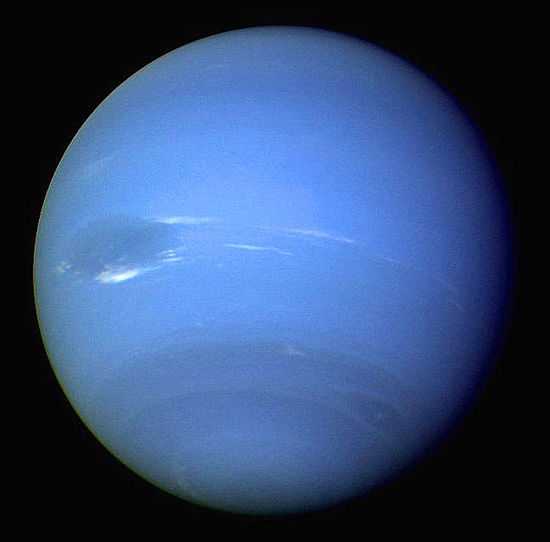
“Neptune is never visible to the naked eye, having a brightness between magnitudes +7.7 and +8.0,[47][48]”.[49]
“Neptune ... was the Roman god of water and the sea[50] in Roman mythology and religion. He is the counterpart of the Greek god Poseidon. In the [interpretatio graeca] Greek-influenced tradition, Neptune was the brother of Jupiter [Italic Neptune has been securely identified as a god of freshwater sources as well as the sea.][50]”[51].
“Syncretic traces of a Lybian/Punic agrarian god of fresh water sources, with the epithet Frugifer, "fruit-bearer"; have been enumerated”.[52][51]
The “German scholar H. Petersmann proposed an etymology from IE rootstem *nebh- related to clouds and foggs ... The concept would be close to that expressed in the name of Greek god [Uranus].”[51]
“Indo-European people, having no direct knowledge of the sea as they originated from inland areas, reused the theology of a deity originally either chthonic or wielding power over inland freshwaters as the god of the sea.[53] This feature has been preserved particularly well in the case of Neptune who was definitely a god of springs, lakes and rivers before becoming also a god of the sea, as is testified by the numerous findings of inscriptions mentioning him in the proximity of such locations. Servius the grammarian also explicitly states Neptune is in charge of all the rivers, springs and waters.[54]”[51]
Locations on Earth
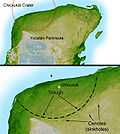
But asteroid impacts, though rare, occur once in a while, over very large areas, at aperiodic intervals such as the Chicxulub crater. Most scientists agree that this impact is the cause of the Cretatious-Tertiary Extinction, 65 million years ago (Ma), that marked the sudden extinction of the dinosaurs and the majority of life then on Earth. This shaded relief image of Mexico's Yucatan Peninsula shows a subtle, but unmistakable, indication of the Chicxulub impact crater.
Prehistory
The prehistory period dates from around 7 x 106 b2k to about 7,000 b2k.
“Saturn has been known since prehistoric times.[55]”.[56]
Ancient history
The ancient history period dates from around 8,000 to 3,000 b2k.
Apparently 5102 b2k (before the year 2000.0), -3102 or 3102 BC, is the historical year assigned to a Hindu table of planets that does include the classical planet Saturn.[57] "Babylonian astronomy, too, had a four-planet system. In ancient prayers the planets Saturn, Jupiter, Mars, and Mercury are invoked; ... and one speaks of "the four-planet system of the ancient astronomers of Babylonia."[58]"[36]
“Babylonian astronomers systematically observed and recorded the movements of Saturn.[59]”[56].
“Ancient Chinese and Japanese culture designated the planet Saturn as the earth star”[56].
“In ancient Hebrew, Saturn is called 'Shabbathai'.[60] Its angel is Cassiel. Its intelligence or beneficial spirit is Agiel (layga) and its spirit (darker aspect) is Zazel (lzaz).”[56].
“In Ottoman Turkish, Urdu and Malay, its name is 'Zuhal'”[56].
Anu
Anu may be an early Sumerian, Akkadian, and Babylonian name for Saturn.
"An, the oldest and highest of the Sumero-Babylonian gods, whose primordial age was "the year of abundance," signified Saturn, according to Jensen.6"[61]
Baal-hamon
"The potential cruelty of Saturn was enhanced by his identification with Cronus, known for devouring his own children. He was thus equated with the Carthaginian god Ba'al Hammon, to whom children were supposedly sacrificed. Saturn was also among the gods the Romans equated with Yahweh, whose Sabbath (on Saturday) he shared as his holy day."[62]
"Modern scholars identify [Baal-hamon] variously with the Northwest Semitic god El or with Dagon.[63]"[64]
"Ancient Greek writers identified him with the Titan Cronus. In ancient Rome, he was identified with Saturn"[64].
Brahma
"The Hindu Brahma, Yama, Vishnu, and Manu converge as representatives of a solitary supreme god and creator governing a lost paradise as the first king, setting forth the first moral codes, and imparting to mankind the fundamentals of civilization."[56]
Cronus
“The Greeks had made the outermost planet sacred to Cronus,[65] and the Romans followed suit.”[56].
El
"In the Canaanite religion, or Levantine religion as a whole, Ēl or Il was the supreme god, the father of humankind and all creatures and the husband of the goddess Asherah as recorded in the clay tablets of Ugarit ... The noun ʾēl was found at the top of a list of gods as the "Ancient of gods" or the "Father of all gods", in the ruins of the royal archive of the Ebla civilization, in the archaeological site of Tell Mardikh in Syria dated to 2300 BC."[66]
"Ēl (rendered Elus or called by his standard Greek counterpart Cronus) is not the creator god or first god. Ēl is rather the son of Sky and Earth."[66]
"Joseph Fontenrose first demonstrated that, whatever their deep origins, at Ugarit Dagon was identified with El,[67]"[68]
Osiris
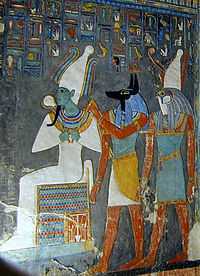
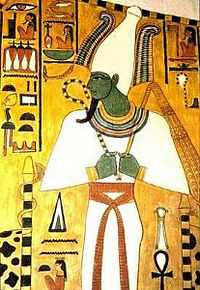
"Osiris is the mythological father of the god Horus, whose conception is described in the Osiris myth, a central myth in ancient Egyptian belief. The myth described Osiris as having been killed by his brother Seth, who wanted Osiris' throne. Isis joined the fragmented pieces of Osiris, but the only body part missing was the phallus. Isis fashioned a golden phallus, and briefly brought Osiris back to life by use of a spell that she learned from [Geb] her father. This spell gave her time to become pregnant by Osiris before he again died. Isis later gave birth to Horus. As such, since Horus was born after Osiris' resurrection, Horus became thought of as a representation of new beginnings and the vanquisher of the evil Set."[69]
"The Phoenician El - Saturn - has four eyes, as does the Orphic Kronos (Saturn)."[61]
"The Chinese Yellow Emperor Huang-ti--identified as Saturn--is also four-eyed.74"[61]
"Osiris, as the Ram of Mendes, is the god of "four faces on one neck."62"[61]
Romulus
Def. in Roman mythology, "[t]he legendary founder of Rome and the twin brother of Remus"[70] is called Romulus.
"Ioannes the Lydian, writing in the sixth century on the usage of his native town, says: 'Our own Philadelpheia still preserves a trace of the ancient belief. On the first day of the month (sc. January) there goes in procession no less a personage than Ianus himself, dressed up in a two-faced mask, and people call him Saturnus, identifying him with Kronos2.'"[71]
"The twins [Romulus and Remus], as in the case of Janus, attach themselves to the Universal Monarch as his two faces, looking in opposite directions."[61]
Saturnus
“In ancient Roman mythology, the god Saturnus, from which the planet takes its name, was the god of agriculture.[72] The Romans considered Saturnus the equivalent of the Greek god Cronus.[72]”[56].
“The Latins considered Saturn the predecessor of Jupiter. Saturn reigned in Latium during a mythical Golden Age reenacted every year at the festival of Saturnalia. Saturn also retained primacy in matters of agriculture and money. Unlike the Greek tradition of Cronus and Zeus, the usurpation of Saturn as king of the gods by Jupiter was not viewed by the Latins as violent or hostile; Saturn continued to be revered in his temple at the foot of the Capitol Hill, which maintained the alternative name Saturnius into the time of Varro.[73]”[74]
Sciences
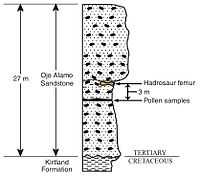
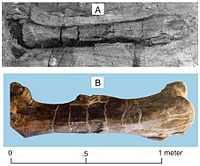
"A hiatus of about 8 m.y. separates Late Cretaceous from Tertiary rocks in the [San Juan] Basin. Most of the missing strata are from the Maastrichtian Stage. The unconformity is overlain by the Ojo Alamo Sandstone in the south and underlain by the Kirtland or Fruitland Formation at most other places in the basin."[75]
The right femur of the hadrosaurian dinosaur is shown at left where the bone is in place in A and after excavation, preparation, and mounting in B.
"[P]ollen was the more accurate age indicator and therefore the Ojo Alamo dinosaurs were Paleocene in age. The conclusion was tentative because Paleocene pollen nowhere occurred at exactly the same locality as dinosaur bone. Paleocene pollen is present, however, in the Ojo Alamo near Barrel Spring, within one mile of the Alamo Wash bone locality [...]."[75]
Original research
- See also: Original research inquiry and Research
Hypothesis:
- It is possible that at some point in hominin existence, the Sun with the Earth in orbit around it was in a binary system with a second star.
- With the orbit of the Earth around the Sun being similar to what it is now, the axial tilt of the Earth being similar to what it is now, the Earth-Sun system may in turn have been in such an orbit around the second, probably smaller star, that this star was a northern hemisphere pole star for the Earth.
- Any nova-like pulses from the secondary star may have caused widespread death and destruction of life on Earth.
- Hominins in the northern hemisphere or with empires overlapping the equator into the northern hemisphere may have regarded the source of emanations they could see that killed many as one or more deities.
- Survivors who saw phenomena headed for Earth from the secondary star may have come to think of themselves as "chosen" for survival by this deity or deities.
- The approximate number of these major destructive events was probably six or seven.
- See also: Control groups, Proof of concept, and Proof of technology
Peoples or hominins living in the southern hemisphere would have been spiritual but not have deities in the sky they could see or worship.
See also
References
- ↑ "Huitzilopochtli, In: Wikipedia". San Francisco, California: Wikimedia Foundation, Inc. May 22, 2013. Retrieved 2013-05-30.
- 1 2 William Fairfield Warren (1885). Paradise Found The Cradle of the Human Races at the North Pole. Boston: Houghton, Mifflin and Company. http://books.google.com/books?id=Nj4RTbq_xyYC&printsec=frontcover&hl=en#v=onepage&f=false. Retrieved 2013-01-06.
- ↑ Stephen Jay Gould (2002). The Structure of Evolutionary Theory. Boston, Massachusetts: Harvard University Press. pp. 1433. ISBN 0-674-00613-5. http://books.google.com/books?id=nhIl7e61WOUC&printsec=frontcover&hl=en. Retrieved 2012-02-12.
- ↑ Ian Ridpath (2012). A Dictionary of Astronomy. Oxford University Press.
- ↑ M. M. Woolfson (1979). "Cosmogony Today". Quarterly Journal of the Royal Astronomical Society 20 (2): 97-114.
- 1 2 "Cosmogony, In: Wikipedia". San Francisco, California: Wikimedia Foundation, Inc. May 31, 2012. Retrieved 2012-06-06.
- 1 2 3 4 Janet Fang (August 28 2014). "13,000-Year-Old Nanodiamonds Found On Three Continents". IFLScience. Retrieved 2014-08-30.
- 1 2 James Kennett (August 28 2014). "13,000-Year-Old Nanodiamonds Found On Three Continents". IFLScience. Retrieved 2014-08-30.
- 1 2 3 "creationism, In: Wiktionary". San Francisco, California: Wikimedia Foundation, Inc. 29 May 2014. Retrieved 2014-08-28.
- ↑ "creationary, In: Wiktionary". San Francisco, California: Wikimedia Foundation, Inc. 25 August 2014. Retrieved 2014-08-28.
- 1 2 3 "creation, In: Wiktionary". San Francisco, California: Wikimedia Foundation, Inc. 6 August 2014. Retrieved 2014-08-28.
- 1 2 3 4 "create, In: Wiktionary". San Francisco, California: Wikimedia Foundation, Inc. 24 August 2014. Retrieved 2014-08-28.
- 1 2 "intelligent design, In: Wiktionary". San Francisco, California: Wikimedia Foundation, Inc. 22 July 2014. Retrieved 2014-08-28.
- ↑ Horatio Hackett Newman (1926). Evolution, Genetics And Eugenics.
- ↑ Philip Clayton and Zachary R. Simpson (1926). The Oxford Handbook of Religion and Science. Oxford University Press. pp. 735. ISBN 0199279276.
- ↑ "traducianism, In: Wiktionary". San Francisco, California: Wikimedia Foundation, Inc. 25 May 2014. Retrieved 2014-08-28.
- 1 2 "soul, In: Wiktionary". San Francisco, California: Wikimedia Foundation, Inc. 7 July 2014. Retrieved 2014-08-28.
- 1 2 3 4 5 "Bible, In: Wiktionary". San Francisco, California: Wikimedia Foundation, Inc. 3 August 2014. Retrieved 2014-08-28.
- ↑ Joseph Campbell (June 26, 2008). The Masks of God: Occidental Mythology. Paw Prints. pp. 564. ISBN 1439508925. http://books.google.com/books?id=fqGdPwAACAAJ&hl=en. Retrieved 2013-01-06.
- ↑ Manly Palmer Hall (1928). Secret Teachings of All Ages. San Francisco: Hall Publishing Company. pp. 648. http://books.google.com/books?id=FDSab8rWZScC&pg=PR1&source=gbs_selected_pages&cad=3. Retrieved 2013-01-06.
- 1 2 "Allah, In: Wiktionary". San Francisco, California: Wikimedia Foundation, Inc. 11 July 2014. Retrieved 2014-08-28.
- ↑ Anne Rice (1998). The Vampire Armand. New York: Knopf. pp. 273. ISBN 9780679454472.
- 1 2 3 4 5 6 7 "God, In: Wiktionary". San Francisco, California: Wikimedia Foundation, Inc. 20 August 2014. Retrieved 2014-08-28.
- ↑ Glenn D. Lowry (1987). "Humayun's Tomb: Form, Function, and Meaning in Early Mughal Architecture". Muqarnas 4: 133-48. doi:10.2307/1523100. http://www.jstor.org/stable/10.2307/1523100. Retrieved 2012-04-24.
- ↑ "extinction, In: Wiktionary". San Francisco, California: Wikimedia Foundation, Inc. November 28, 2012. Retrieved 2013-01-08.
- ↑ "extinct, In: Wiktionary". San Francisco, California: Wikimedia Foundation, Inc. October 16, 2012. Retrieved 2013-01-08.
- 1 2 "volution, In: Wiktionary". San Francisco, California: Wikimedia Foundation, Inc. September 15, 2010. Retrieved 2014-05-12.
- 1 2 "evolution, In: Wiktionary". San Francisco, California: Wikimedia Foundation, Inc. December 23, 2012. Retrieved 2013-01-08.
- ↑ "Evolution, In: Wikipedia". San Francisco, California: Wikimedia Foundation, Inc. July 28, 2012. Retrieved 2013-01-08.
- 1 2 Ernst Mayr (2001). What Evolution Is. New York: Basic Books. pp. 336. ISBN 0-465-04425-5. http://books.google.com/books?id=i8jx-ZyRRkkC&printsec=frontcover&hl=en#v=onepage&f=false. Retrieved 2012-02-12.
- ↑ Egbert Giles Leigh Jr. (December 1999). "The modern synthesis, Ronald Fisher and creationism". Trends in Ecology & Evolution 14 (12): 495-8. doi:10.1016/S0169-5347(99)01725-5. http://bill.srnr.arizona.edu/classes/449/Opinion/Leigh%20-%201999.pdf. Retrieved 2012-02-14.
- ↑ George Gaylord Simpson (1944). Tempo and Mode in Evolution. New York: Columbia University Press. pp. 237.
- ↑ David M. Raup (July 1994). "The role of extinction in evolution". Proceedings of the National Academy of Sciences of the United States of America 91 (15): 6758-63. http://www.pnas.org/content/91/15/6758.full.pdf. Retrieved 2011-09-14.
- 1 2 3 4 5 "naturalism, In: Wiktionary". San Francisco, California: Wikimedia Foundation, Inc. 20 April 2014. Retrieved 2014-08-28.
- 1 2 L. Ginzberg (1925). The Legends of the Jews. I. Philadelphia. http://www.varchive.org/itb/hebrew.htm. Retrieved 2014-08-29.
- 1 2 3 4 Immanuel Velikovsky (January 1965). Worlds in Collision. New York: Dell Publishing Co., Inc.. pp. 401. http://books.google.com/books?id=FJst27kSVBgC&pg=PA13&hl=en. Retrieved 2012-01-13.
- ↑ G. Evelyn Hutchinson (November 1969). "Aysheaia and the general morphology of the Onychophora". American Journal of Science 267 (9): 1062-6. doi:10.2475/ajs.267.9.1062. http://www.ajsonline.org/content/267/9/1062.short. Retrieved 2014-08-29.
- ↑ Immanuel Velikovsky. "Planet Ages". Retrieved 2014-08-29.
- ↑ Immanuel Velikovsky. "The Confusion of Languages". Velikovsky Archive. Retrieved 2014-08-29.
- ↑ Immanuel Velikovsky. "Mercury". Velikovsky Archive. Retrieved 2014-08-29.
- ↑ Immanuel Velikovsky. "The Hebrew Cosmogony". Retrieved 2014-08-29.
- ↑ Vicentius Sangermano. Cosmographia Burmana.
- ↑ Immanuel Velikovsky. "A Brighter Moon". Retrieved 2014-08-29.
- ↑ Immanuel Velikovsky. "The Overthrow of the Cities of the Plain". Retrieved 2014-08-29.
- ↑ Immanuel Velikovsky. "“Star of the Sun”". Retrieved 2014-08-29.
- 1 2 Immanuel Velikovsky. "Uranus". Retrieved 2014-08-29.
- ↑ David R. Williams (September 1, 2004). "Neptune Fact Sheet". NASA. Retrieved August 14, 2007.
- ↑ Fred Espenak (July 20, 2005). "Twelve Year Planetary Ephemeris: 1995–2006". NASA. Retrieved March 1, 2008.
- ↑ "Neptune, In: Wikipedia". San Francisco, California: Wikimedia Foundation, Inc. June 1, 2012. Retrieved 2012-06-08.
- 1 2 J. Toutain, Les cultes païens de l'Empire romain, vol. I (1905:378)
- 1 2 3 4 "Neptune (mythology), In: Wikipedia". San Francisco, California: Wikimedia Foundation, Inc. April 9, 2013. Retrieved 2013-04-09.
- ↑ Alain Cadotte, "Neptune Africain", Phoenix 56.3/4 (Autumn/Winter 2002:330-347)
- ↑ G. Wissowa Religion un Kultus der Römer Munich, 1912; A. von Domaszewski Abhandlungen zur römische Religion Leipzig und Berlin, 1909; R. Bloch above
- ↑ Raymond Bloch "Quelques remarques sur Poseidon, Neptunus and Nethuns" in Revue de l'Histoire des Religions 1981 p.341-352, p.346; Servius Ad Georgicae IV 24
- ↑ "Saturn > Observing Saturn". National Maritime Museum. Archived from the original on 2007-04-22. Retrieved 2007-07-06.
- 1 2 3 4 5 6 7 8 "Saturn, In: Wikipedia". San Francisco, California: Wikimedia Foundation, Inc. May 8, 2012. Retrieved 2012-05-11.
- ↑ Jean Baptiste Joseph Delambre (1817). Histoire de l'astronomie ancienne. Paris: Courcier. pp. 639. http://books.google.com/books?id=2lVUjJSxjhQC&pg=PR3&source=gbs_selected_pages&cad=3#v=onepage&f=false. Retrieved 2012-01-13.
- ↑ Ernst Friedrich Weidner (1915). Handbuch der babylonischen Astronomie, Volume 1. J. C. Hinrichs. pp. 146. http://books.google.com/books?id=K6NDAAAAYAAJ&hl=en. Retrieved 2012-03-30.
- ↑ A. Sachs (May 2, 1974). "Babylonian Observational Astronomy". Philosophical Transactions of the Royal Society of London (Royal Society of London) 276 (1257): 43–50 [45 & 48–9]. doi:10.1098/rsta.1974.0008.
- ↑ Cessna, Abby (November 15, 2009). "When Was Saturn Discovered?". Universe Today. Archived from the original on 2011-10-05. Retrieved July 21, 2011.
- 1 2 3 4 5 David N. Talbott (1980). The Saturn Myth. Garden City, New York, USA: Knopf Doubleday & Company, Inc.. pp. 419. ISBN 0-385-11376-5. http://books.google.com/books?id=tNVlQgAACAAJ&hl=en. Retrieved 2013-01-03.
- ↑ "Saturn (mythology), In: Wikipedia". San Francisco, California: Wikimedia Foundation, Inc. October 14, 2012. Retrieved 2012-10-15.
- ↑ "Carthaginian Religion by Roy Decker". About.com. Retrieved 2010-07-07.
- 1 2 "Baal-hamon, In: Wikipedia". San Francisco, California: Wikimedia Foundation, Inc. May 11, 2012. Retrieved 2012-10-15.
- ↑ James Evans (1998). The History and Practice of Ancient Astronomy. Oxford University Press. pp. 296–7. ISBN 978-0-19-509539-5.
- 1 2 "El (deity), In: Wikipedia". San Francisco, California: Wikimedia Foundation, Inc. October 11, 2012. Retrieved 2012-10-15.
- ↑ Joseph Fontenrose, "Dagon and El" Oriens 10.2 (December 1957), pp. 277-279.
- ↑ "Dagon, In: Wikipedia". San Francisco, California: Wikimedia Foundation, Inc. September 30, 2012. Retrieved 2012-10-15.
- ↑ "Osiris, In: Wikipedia". San Francisco, California: Wikimedia Foundation, Inc. January 22, 2013. Retrieved 2013-01-22.
- ↑ "Romulus, In: Wiktionary". San Francisco, California: Wikimedia Foundation, Inc. January 14, 2013. Retrieved 2013-03-03.
- ↑ Arthur Bernard Cook (1925). Zeus: A Study in Ancient Religion, Volume 2: Zeus God of the Dark Sky (Thunder and Lightning), Part 1. New York, New York USA: Cambridge University Press. pp. 1397. http://books.google.com/books?id=Ys83AAAAIAAJ&printsec=frontcover&hl=en&sa=X&ei=te0zUaKEKfDp0QHms4HABg&ved=0CCUQ6AEwAQ#v=onepage&q&f=false. Retrieved 2013-03-03.
- 1 2 "Starry Night Times". Imaginova Corp. 2006. Archived from the original on 2011-08-21. Retrieved 2007-07-05.
- ↑ Varro V 42; Vergil Aeneis VIII 357-8; Dionysius Hal. I 34; Solinus I 12; Festus p. 322 L; Tertullian Apologeticum 10; Macrobius I 7, 27 and I 10, 4 citing a certain Mallius. See also Macrobius I 7, 3: the annalistic tradition attributed its foundation to king Tullus Hostilius. Studies by E. Gjerstad in Mélanges Albert Grenier Bruxelles 1962 p. 757-762; Filippo Coarelli in La Parola del Passato 174 1977 p. 215 f.
- ↑ "Jupiter (mythology), In: Wikipedia". San Francisco, California: Wikimedia Foundation, Inc. May 11, 2012. Retrieved 2012-05-11.
- 1 2 J.E. Fassett, S.G. Lucas, R.A. Zielinski, and J.R. Budahn (May 2001). SG Lucas, RA Zielinski, and JR Budahn. ed. Compelling new evidence for Paleocene dinosaurs in the Ojo Alamo Sandstone, San Juan Basin, New Mexico and Colorado, USA, In: Catastrophic events and mass extinctions, Lunar and Planetary Contribution. 1053. pp. 45-6. Bibcode: 2001caev.conf.3139F. http://www.lpi.usra.edu/meetings/impact2000/pdf/3139.pdf. Retrieved 2014-08-29.
Further reading
- William Fairfield Warren (1885). Paradise Found The Cradle of the Human Races at the North Pole. Boston: Houghton, Mifflin and Company. http://books.google.com/books?id=Nj4RTbq_xyYC&printsec=frontcover&hl=en#v=onepage&f=false. Retrieved 2013-01-06.
External links
- Hit counter To see how often this page is viewed, enter Wikiversity, then the page title.
- African Journals Online
- Bing Advanced search
- Google Books
- Google scholar Advanced Scholar Search
- JSTOR
- Lycos search
- NCBI All Databases Search
- Office of Scientific & Technical Information
- Questia - The Online Library of Books and Journals
- SAGE journals online
- Scirus for scientific information only advanced search
- SpringerLink
- Taylor & Francis Online
- Wiley Online Library Advanced Search
- Yahoo Advanced Web Search
| |||||||||||||||||||||||||||||||||||||||||||||||||||||
| ||||||||||||||||||||||||||||||||||||||
| |||||||||||||||||||||||||||||||||||||||||||||||||||||
![]() This is a research project at http://en.wikiversity.org
This is a research project at http://en.wikiversity.org
| |
Educational level: this is a research resource. |
| |
Resource type: this resource is an article. |
| |
Resource type: this resource contains a lecture or lecture notes. |
| |
Subject classification: this is an Anthropology resource. |
| |
Subject classification: this is an archaeology resource. |
| |
Subject classification: this is an astronomy resource. |
| |
Subject classification: this is a Geology resource. |
| |
Subject classification: this is a humanities resource. |
| |
Subject classification: this is a religious resource . |
| |
Subject classification: this is a science resource . |